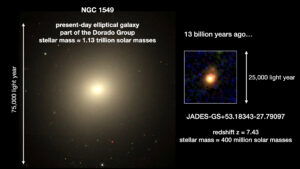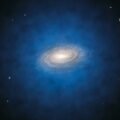Scientists using the James Webb Space Telescope have spotted an ‘inside-out’ galaxy that formed around 13 billion years ago. Like a large city, the galaxy has its densest collection of stars at its core. However, that density decreases as one moves from the city center to the galactic ‘suburbs,’ giving the galaxy its inside-out shape.
Although scientists have seen similarly shaped galaxies form in the last 10 million years, the unique ability of the JWST to peer billions of years back in time has revealed a truly ancient galaxy coming to life in much the same way.
“The question of how galaxies evolve over cosmic time is an important one in astrophysics,” said Dr. Sandro Tacchella from Cambridge’s Cavendish Laboratory and the study’s co-lead author. “We’ve had lots of excellent data for the last ten million years and for galaxies in our corner of the universe, but now, with Webb, we can get observational data from billions of years back in time, probing the first billion years of cosmic history, which opens up all kinds of new questions.”
An Inside-Out Galaxy This Old Has Never Been Seen Before
Astronomers generally agree that the galaxies studied by previous telescopes that formed in the last 10 million years typically do so in one of two ways. Some gather, or accrete, gas from their surrounding cloud and use that as material and fuel for new star formation, while other galaxies grow by merging with smaller galaxies. According to the study’s authors, finding a galaxy that matured this rapidly only 700 million years after the Big Bang could help them answer age-old questions about how galaxies formed throughout the universe’s history.
“You expect galaxies to start small as gas clouds collapse under their own gravity, forming very dense cores of stars and possibly black holes,” Tacchella explained. “As the galaxy grows and star formation increases, it’s sort of like a spinning figure skater: as the skater pulls in their arms, they gather momentum, and they spin faster and faster.”
Galaxies operate in a somewhat similar way. As time passes and gas accretes from farther and farther away, the galaxy spins up faster and faster. According to Tacchella, this explains why galaxies often form spiral or disc shapes.
James Webb Space Telescope Peers Back in Time
Part of the JADES (JWST Advanced Extragalactic Survey), this work involved scanning the various light spectra coming from NGC 1549 using the JWST’s advanced instruments. This data allowed the team to estimate the number and location of older and younger stars, which they were able to convert into estimates for stellar mass and stellar formation rate.
Surprisingly, the team found that the density of the galaxy’s core was similar to the massive elliptical galaxies seen today, even though they have 1000 times more stars than NGC 1549. They also spotted the inside-out galaxy distribution of stellar formations usually associated with much younger galaxies. The team says that their models had predicted this type of stellar formation. But before the JWST, looking back 13 million years to confirm these models was impossible.
“One of the many reasons that Webb is so transformational to us as astronomers is that we’re now able to observe what had previously been predicted through modelling,” said co-author William Baker, a PhD student at the Cavendish. “It’s like being able to check your homework.”


Due to the compact nature of this inside-out galaxy, the team says the individual images collected by the JWST were ‘forward modeled” to account for “instrumental effects” during the data collection process. This modeling, which included prescriptions for dust absorption and gas emissions, revealed a host of older stars at the galaxy’s core and active stellar formation in the surrounding outer disc. They even saw a second “lump” of star formation further out.
Their modeling also found that the stellar mass in the galaxy’s outskirts appears to be doubling every 10 million years. The researchers say this is “very rapid,” as our Milky Way Galaxy is expected to double its mass every 10 billion years.
Was the Early Universe Dramatically Different?
In the study’s conclusion, the authors point out that their initial analysis of NGC 1549 suggests conditions in the early universe may have been dramatically different than they are today. Specifically, they hypothesize that the dense galactic core and the high rate of star formation may mean the early universe was rich with the gas this inside-out galaxy needed to form new stars at such a rapid rate. However, they also concede that more observations of galaxies formed during this ancient time frame would be needed to offer any conclusive evidence of a dramatically different early Universe.
“Of course, this is only one galaxy, so we need to know what other galaxies at the time were doing,” said Tacchella. “Were all galaxies like this one? We’re now analysing similar data from other galaxies.”
“By looking at different galaxies across cosmic time, we may be able to reconstruct the growth cycle and demonstrate how galaxies grow to their eventual size today,” Tacchella added.
The study “A core in a star-forming disc as evidence of inside-out growth in the early Universe” was published in Nature Astronomy.
Christopher Plain is a Science Fiction and Fantasy novelist and Head Science Writer at The Debrief. Follow and connect with him on X, learn about his books at plainfiction.com, or email him directly at christopher@thedebrief.org.

